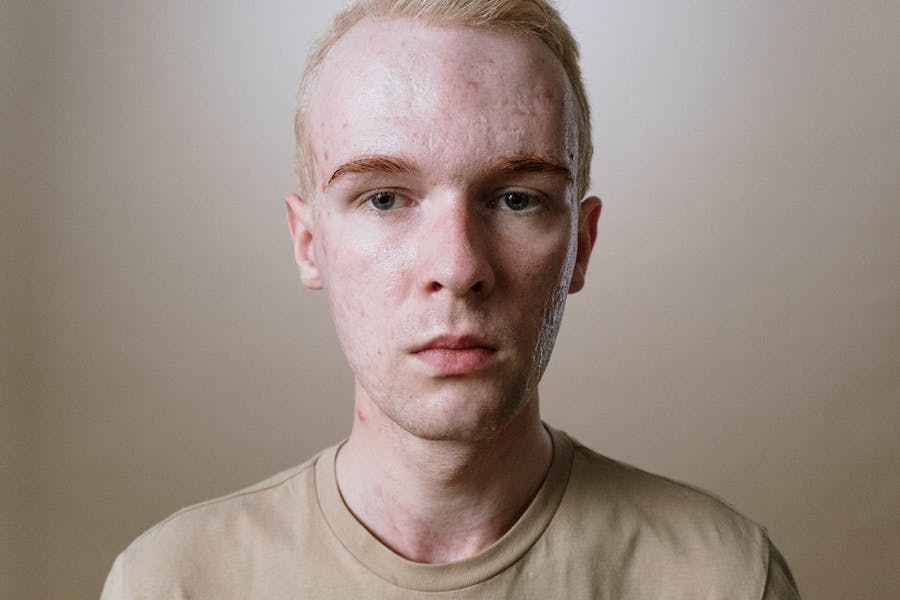The use of whey protein supplements has surged in recent years, driven by fitness enthusiasts and health-conscious individuals seeking to boost their protein intake. However, for some, this dietary choice comes with an unexpected consequence: acne breakouts. Acne attributed to whey protein consumption has raised concerns and prompted individuals to seek ways to enjoy the benefits of protein supplementation without unwanted skin issues. In this article, we will explore the connection between whey protein and acne and provide practical guidance on how to prevent these pesky breakouts, ensuring a clear complexion alongside your fitness goals.
How To Prevent Acne From Whey Protein?
- Choose the Right Whey Protein: Opt for high-quality whey protein isolate instead of whey protein concentrate. Isolate contains fewer fats and lactose, which may be less likely to trigger acne.
- Gradual Introduction: When incorporating whey protein into your diet, start with small amounts and gradually increase the serving size over a few days or weeks. This can help your body adapt without overwhelming your system.
- Monitor Protein Intake: Keep track of your daily protein intake. Ensure you are not consuming excessive amounts of protein, as this can lead to acne breakouts. The recommended daily intake of protein varies depending on factors like age, gender, and activity level, so consult with a healthcare professional or dietitian to determine your specific needs.
- Stay Hydrated: Drinking plenty of water can help flush toxins from your body and promote healthy skin. Aim for at least 8-10 glasses of water a day to maintain hydration.
- Maintain a Balanced Diet: Ensure your diet includes a variety of nutrient-rich foods. Incorporate fruits, vegetables, whole grains, and healthy fats to support overall skin health. Avoid excessive consumption of dairy products if you suspect they might be contributing to your acne.
- Skincare and Hygiene: Establish a regular skincare routine that includes gentle cleansing and the use of non-comedogenic (non-pore-clogging) skincare products. Proper hygiene can help prevent acne breakouts.
- Manage Stress: High stress levels can exacerbate acne. Incorporate stress management techniques such as meditation, yoga, or regular exercise into your daily routine to keep stress at bay
Understanding Acne and Its Causes
Acne, a common skin condition, affects millions of people worldwide, particularly during adolescence and early adulthood. It is characterized by the appearance of pimples, blackheads, whiteheads, and sometimes even painful cysts on the face, neck, chest, back, and shoulders. Acne occurs when hair follicles become clogged with oil, dead skin cells, and bacteria. While it is generally not a severe health concern, acne can be emotionally distressing and affect one’s self-esteem.
The primary cause of acne is the overproduction of sebum, an oily substance produced by the sebaceous glands in the skin. Sebum normally helps keep the skin lubricated and prevents it from drying out. However, an excess of sebum can lead to clogged pores, creating an ideal environment for the proliferation of the acne-causing bacterium Propionibacterium acnes. This, in turn, triggers an inflammatory response by the body, resulting in the formation of acne lesions.

In addition to sebum overproduction, several other factors contribute to the development of acne. Hormonal fluctuations play a significant role, particularly during puberty when the body undergoes substantial hormonal changes. These fluctuations can stimulate the sebaceous glands to produce more sebum, making teenagers more prone to acne breakouts. Genetics also plays a role; if your parents had acne, you may be more likely to experience it as well. Additionally, certain medications, environmental factors, and dietary choices can exacerbate acne symptoms. Understanding these underlying causes of acne is crucial for developing effective prevention and treatment strategies.
Identifying Acne Triggered By Whey Protein
Recognizing acne triggered by whey protein consumption is essential for taking steps to prevent it effectively. Here are some key insights on how to identify this specific type of acne:
- Timing and Consistency: Pay attention to the timing of your acne breakouts. If you notice that pimples consistently appear shortly after consuming whey protein, it could indicate a correlation. Keep a diary to track the frequency and severity of breakouts about your protein intake.
- Acne Location: Take note of where the acne appears on your body. Acne caused by whey protein is often seen on the face, neck, chest, and back, as these areas have more sebaceous glands that can be affected by dietary factors.
- Other Symptoms: Be mindful of any other symptoms or discomfort you experience alongside acne breakouts after consuming whey protein. These may include digestive issues, bloating, or skin itching, which can be indicative of an underlying allergy or sensitivity to whey protein.
- Elimination Test: Consider conducting an elimination test. Temporarily remove whey protein from your diet and observe if your acne improves. If it does, reintroduce whey protein and see if the acne returns. This can help confirm the link between whey protein and your skin issues.
- Consultation with a Dermatologist: If you suspect that your acne is related to whey protein consumption, it’s advisable to consult with a dermatologist. They can assess your skin condition, perform tests for allergies or sensitivities, and provide expert guidance on managing your acne.
- Skin Patch Test: In some cases, a dermatologist may recommend a skin patch test to identify specific allergens or irritants that could be triggering your acne. This test can help pinpoint the exact cause of your skin issues, including whey protein sensitivity.
Alternative Protein Sources
If you’ve identified whey protein as a trigger for your acne or if you simply want to explore other protein options, there are plenty of alternative protein sources that can provide the nutrition your body needs without causing skin issues. Here are some excellent alternatives to whey protein:
Plant-Based Proteins:
- Pea Protein: Derived from yellow peas, pea protein is an excellent source of protein and is easy to digest. It is also hypoallergenic, making it a suitable choice for individuals with allergies or sensitivities.
- Hemp Protein: Hemp protein is rich in essential fatty acids and is a complete protein source. It contains all nine essential amino acids and is easily digestible.
- Soy Protein: Soy protein is a complete protein and is often used as a substitute for animal-based protein sources. It’s available in various forms, including soy protein isolate and soy protein concentrate.
Other Dairy-Free Proteins:
- Almond Protein: Almond protein is a good option for those with nut allergies. It’s low in carbohydrates and provides essential nutrients.
- Rice Protein: Rice protein is hypoallergenic and suitable for people with various dietary restrictions. It’s also easy on the digestive system.
Animal-Based Proteins:
- Chicken: Skinless chicken breast is a lean source of protein that is low in saturated fat and can be prepared in various ways.
- Fish: Fatty fish like salmon, mackerel, and trout are not only high in protein but also rich in omega-3 fatty acids, which are beneficial for overall health.
- Lean Beef: Lean cuts of beef, such as sirloin or tenderloin, provide protein along with essential vitamins and minerals like iron and zinc.
- Eggs: Eggs are a versatile protein source, rich in essential amino acids. They can be prepared in numerous ways and are a staple in many diets.
Plant-Based Whole Foods:
- Legumes: Beans, lentils, and chickpeas are excellent sources of plant-based protein. They are also high in fiber and provide essential nutrients.
- Nuts and Seeds: Incorporating nuts like almonds, peanuts, and seeds such as chia, flax, and pumpkin seeds into your diet can boost your protein intake.
Dairy Alternatives:
These dairy alternatives are often fortified with protein and can be used in place of traditional dairy milk in recipes and beverages. When choosing alternative protein sources, it’s important to maintain a balanced diet that meets your nutritional needs. Consulting with a registered dietitian or nutritionist can help you create a well-rounded meal plan that ensures you get the protein and other essential nutrients your body requires while avoiding potential acne triggers like whey protein.
Final words
In conclusion, preventing acne caused by whey protein involves careful consideration of your dietary choices, monitoring your body’s responses, and exploring alternative protein sources. By understanding the underlying causes of your acne and making informed decisions, you can maintain clear and healthy skin while meeting your protein needs. Remember that individual responses vary, so seeking professional guidance when needed is essential for achieving the best results in your journey to acne-free skin.
FAQs
Q1: Can Whey Protein Cause Acne?
Yes, for some individuals, whey protein consumption can trigger acne breakouts due to hormonal changes and allergic reactions.
Q2: What Is The Difference Between Whey Protein Isolate And Concentrate?
Whey protein isolate contains fewer fats and lactose than concentrate, making it a better choice for those concerned about acne.
Q3: Can I Still Consume Dairy If Whey Protein Triggers Acne?
It depends on individual tolerance. Some may tolerate dairy in moderation, while others may need to avoid it entirely.
Q4: Are Plant-Based Protein Sources Less Likely To Cause Acne?
Plant-based proteins like pea or hemp protein are often less associated with acne, but individual responses vary.
Q5: How Long Should I Eliminate Whey Protein To See If It’s Causing My Acne?
It’s recommended to eliminate whey protein for at least a few weeks to assess any changes in your skin before reintroducing it to test for a connection.





